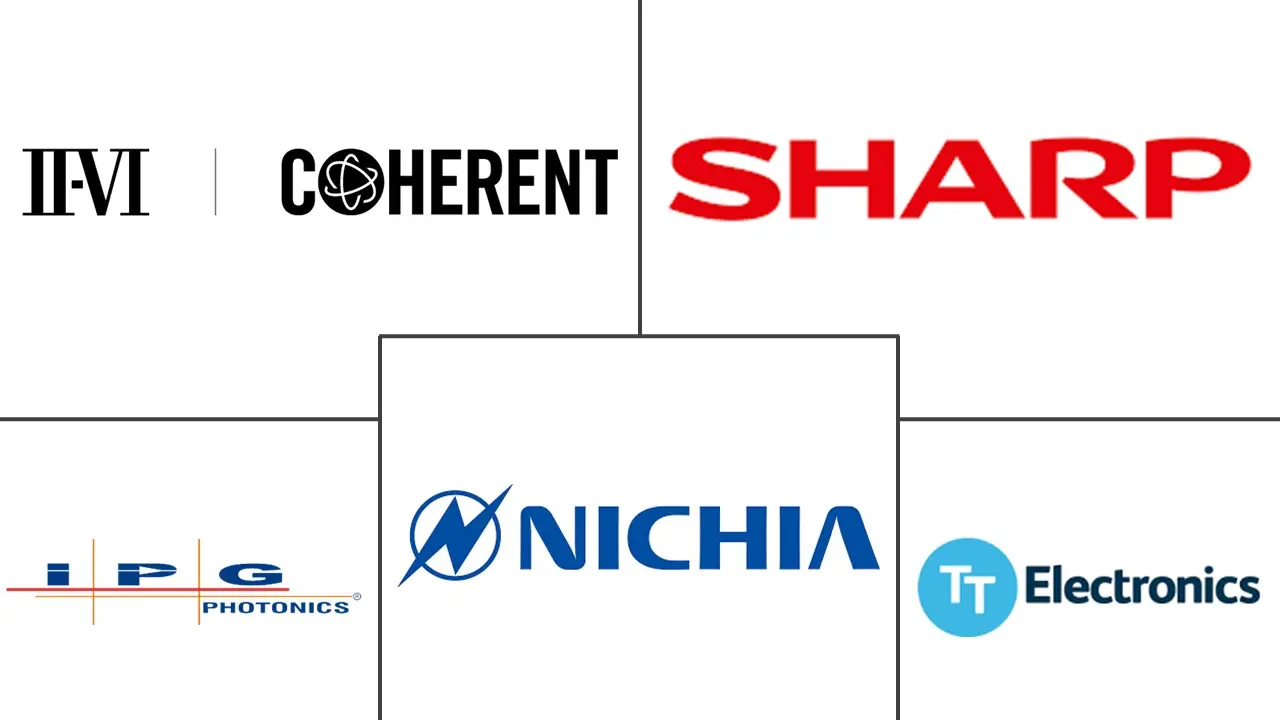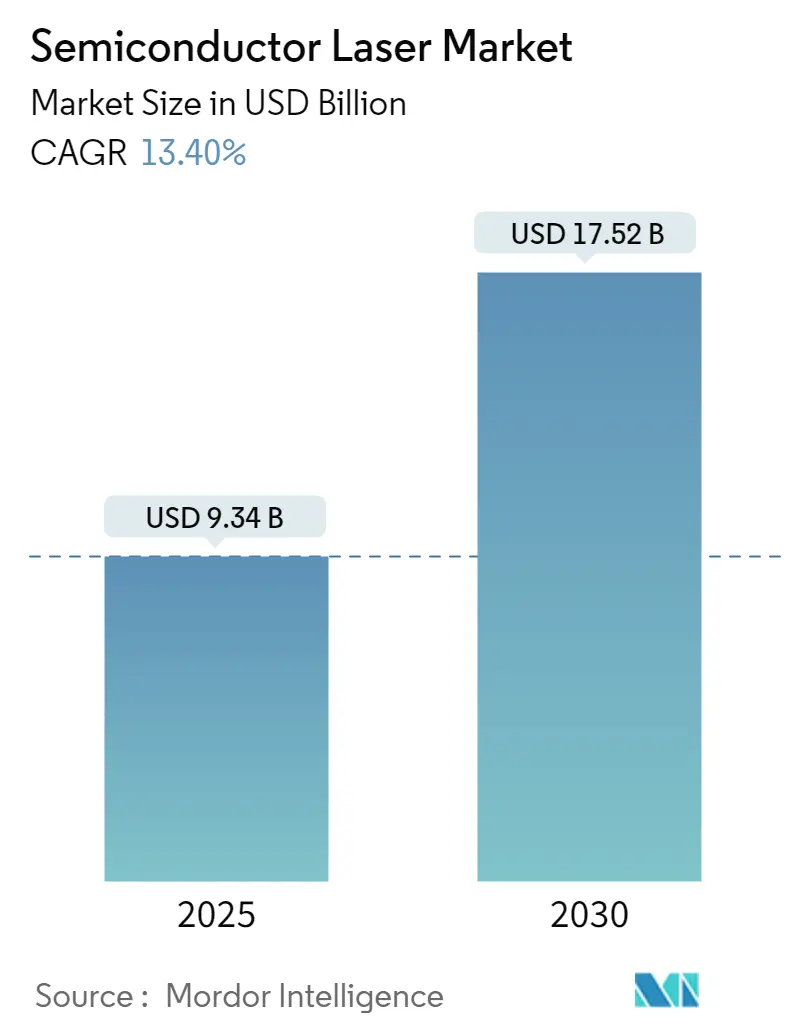
Semiconductor Laser Market Analysis
The Semiconductor Laser Market size is estimated at USD 9.34 billion in 2025, and is expected to reach USD 17.52 billion by 2030, at a CAGR of 13.4% during the forecast period (2025-2030).
The semiconductor laser industry is experiencing transformative changes driven by the rapid evolution of telecommunications infrastructure and digital connectivity. The emergence of advanced communication networks, particularly 5G and upcoming 6G technologies, has created unprecedented demands for high-speed data transmission capabilities. According to recent data, Puerto Rico leads global 5G availability with users spending 48.4% of their time connected to 5G services in 2023, followed by South Korea and Kuwait at 42.9% and 39.4% respectively. This widespread adoption of next-generation communication technologies has accelerated the development of more sophisticated semiconductor laser solutions optimized for high-bandwidth applications.
The industry is witnessing significant technological advancements in Vertical-Cavity Surface-Emitting Lasers (VCSELs) and quantum dot laser technologies. These innovations are particularly crucial for optical links based on multimode fiber in data centers and high-performance computers. Recent designs focus on creating more energy-efficient VCSELs capable of maintaining high modulation bit rates at room temperature without requiring parameter adjustments, even under elevated temperature conditions. The integration of nanostructured semiconductor lasers, especially quantum dots, has become increasingly prevalent in optical telecommunication devices due to their superior optical gain characteristics.
The exponential growth in data center infrastructure is reshaping the semiconductor laser landscape. According to Cloud Scene's September 2023 data, China leads the Asia-Pacific region with 448 data centers, ranking fourth globally. This massive data center expansion is driven by the increasing adoption of cloud applications, artificial intelligence, machine learning, and augmented reality technologies. The demand for efficient data processing and information interaction has created new opportunities for semiconductor laser applications in optical interconnects and communication systems.
Global investments in semiconductor manufacturing capabilities are reaching unprecedented levels, reflecting the strategic importance of this technology. Japan's approval of a JPY 774 billion (USD 4.93 billion) semiconductor investment package, including a significant subsidy for TSMC's new foundry in Kumamoto prefecture, demonstrates the scale of national commitments to semiconductor technology development. These investments are complemented by initiatives like India's national strategy for additive manufacturing, which aims to establish global hubs for advanced manufacturing technologies, including semiconductor laser applications in 3D printing and other industrial processes.
Semiconductor Laser Market Trends
RISE IN DEMAND FOR SEMICONDUCTOR LASER APPLICATIONS
The proliferation of semiconductor laser applications spans across multiple high-growth sectors, including spectroscopy, smartwatches, laser pointers, bar scanners, flat displays, material processing, thermal printing, solid-state lasers, projection applications, and biotechnology. In the medical sector, particularly, semiconductor lasers have demonstrated remarkable versatility, with recent research highlighting their effectiveness in dental procedures. The 976 nm laser diode, for instance, has shown excellent surgical effectiveness with minimal peripheral damage in oral soft tissue procedures, enabling safe histological diagnosis.
The communication sector represents another major growth driver, particularly in the development of smartphones and flexible display technologies. The adoption of OLEDs in consumer electronic devices has created substantial demand for semiconductor lasers. Samsung Display's entry into the medium-sized OLED market with high-refresh-rate displays for laptops exemplifies this trend. These flexible OLED screens, featuring high brightness, HDR10+ content playback, and improved screen protection, can withstand over 200,000 folds, equivalent to 100 folds and unfolds daily for five years.
GROWTH IN THE FIBER LASER MARKET
Fiber lasers have gained significant momentum due to their capability to generate wavelengths widely used in industrial environments, including welding, cutting, cleaning, marking, drilling, texturing, and other applications. The technology utilizes laser diodes to transform electricity into light, which is then pumped to fiber optical cables. This process involves two different semiconductors for positive and negative charging, enabling current flow and photon generation that is subsequently pumped to the fiber optic cable to generate laser beams.
The expansion of fiber laser applications has been particularly notable in industrial laser cleaning, especially following increased cleaning requirements across various industries. One primary application is rust removal, where fiber lasers can clean and eliminate rust and other corrosion agents with precision while preserving the base metal. Additionally, fiber lasers are increasingly replacing chemical etching and solid-state laser cutting in medical and electronic industries, driving substantial demand for semiconductor lasers as raw materials for fiber laser manufacturing.
PREFERENCE FOR SEMICONDUCTOR LASERS OVER OTHER LIGHT SOURCES
Semiconductor lasers have emerged as the preferred choice across various applications due to their compact size and practical design. Despite their simple construction, these devices are structured in multiple layers, offering versatility and suitability for numerous applications in gadgets, computers, and tools. Their compact size, ranging from 0.2-1 mm in length, combined with their operational efficiency, makes them particularly advantageous despite not necessarily producing the ideal beam of light that other lasers can achieve.
The advantages of semiconductor lasers extend beyond their physical characteristics to include superior energy efficiency and economic benefits. These lasers consume significantly less power compared to conventional lighting techniques and employ long-term operational capabilities. Their elaborate design at the nanometer scale enables passive cooling techniques, making them highly efficient and user-friendly. Unlike other lasers, semiconductor lasers eliminate the need for mirrors to produce laser beams, and they offer a wide range of wavelengths covering much of the visible, near-infrared, and mid-infrared spectral regions, with some devices allowing for wavelength tuning.
Segment Analysis: By Type
Fiber Optic Lasers Segment in Semiconductor Laser Market
The fiber optic lasers segment continues to dominate the semiconductor laser market, holding approximately 31% market share in 2024. This significant market position is driven by the segment's widespread adoption across diverse industrial applications, including cutting, welding, marking, and precision machining operations. The superior beam quality, high power output, and excellent energy efficiency of fiber optic lasers make them particularly attractive for materials processing applications. These lasers are increasingly being integrated into advanced manufacturing processes, especially in the automotive, aerospace, and electronics industries, where precision and reliability are crucial. The segment's growth is further supported by the expanding fiber optic communication networks globally, where these lasers serve as essential components for high-speed data transmission and telecommunications infrastructure.
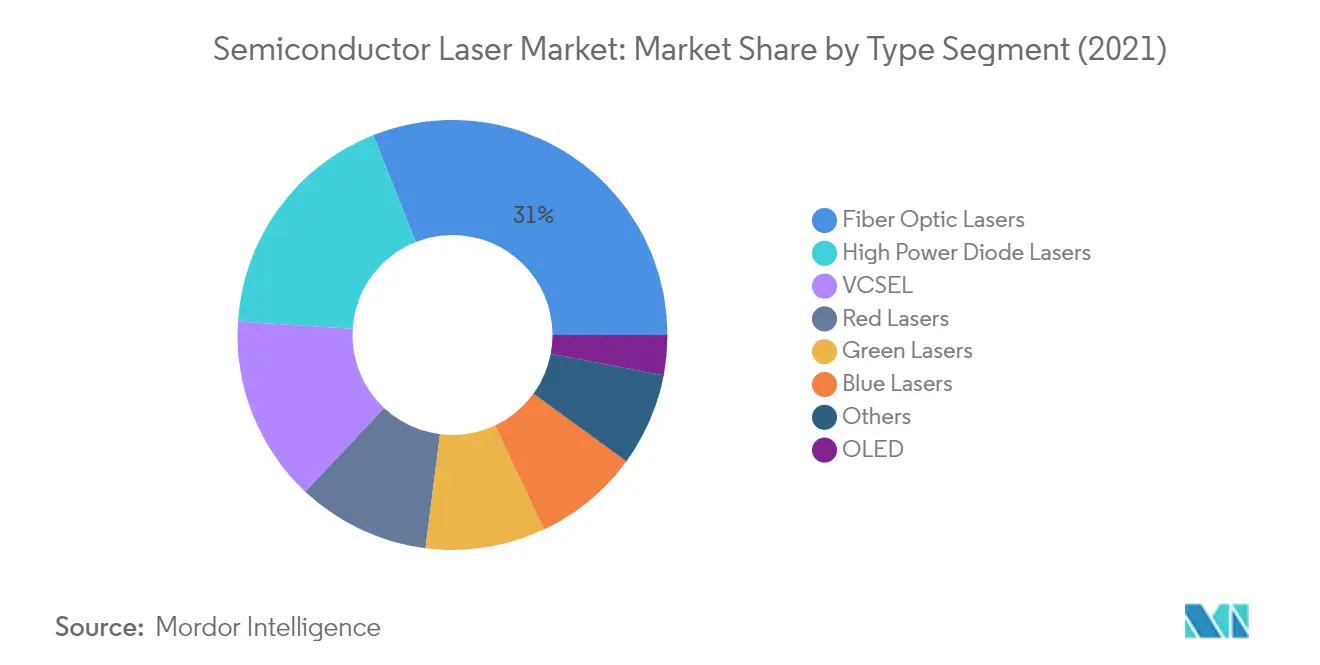
OLED Segment in Semiconductor Laser Market
The OLED (Organic Light Emitting Diode) segment is emerging as the fastest-growing segment in the semiconductor laser market, with an expected growth rate of approximately 11% during 2024-2029. This remarkable growth is primarily driven by the increasing adoption of OLED technology in display applications, particularly in smartphones, tablets, and high-end television sets. The superior display quality, energy efficiency, and flexibility offered by OLED technology are key factors contributing to its rapid market expansion. The segment is witnessing significant technological advancements in terms of improved brightness, longer lifespan, and enhanced color accuracy. The growing demand for flexible displays in wearable devices and the automotive sector is further accelerating the adoption of OLED technology, making it a crucial segment in the semiconductor laser market's future landscape.
Remaining Segments in Semiconductor Laser Market
The semiconductor laser market encompasses several other important segments, including VCSEL, red lasers, high power diode lasers, green lasers, and blue lasers, each serving specific applications and industries. VCSELs are gaining prominence in 3D sensing applications and facial recognition technology, while high power diode lasers are essential for industrial processing and medical applications. Red lasers continue to be vital in optical storage and barcode scanning applications, while green lasers find extensive use in projection systems and medical procedures. Blue lasers are increasingly being adopted in advanced manufacturing processes and entertainment systems. Each of these segments contributes uniquely to the market's diversity and technological advancement, serving specific industry needs and applications.
Segment Analysis: By Application
Communication Segment in Semiconductor Laser Market
The communication segment maintains its dominant position in the semiconductor laser market, commanding approximately 43% market share in 2024. This significant market presence is driven by the extensive use of semiconductor lasers in optical fiber systems, data transmission, and telecommunications infrastructure. The segment's growth is further bolstered by increasing demand for high-speed internet services, cloud computing, and the ongoing deployment of 5G networks globally. Semiconductor lasers serve as critical components in optical communication systems, enabling high-speed data transmission through fiber optic networks. The segment's strength is particularly evident in applications such as optical transceiver modules, coherent optical communication devices, and backbone systems, where semiconductor lasers play a crucial role in signal transmission and reception.
Instrumentation and Sensor Segment in Semiconductor Laser Market
The instrumentation and sensor segment is emerging as the fastest-growing segment in the semiconductor laser market, with an expected growth rate of approximately 10% during 2024-2029. This remarkable growth is driven by the increasing adoption of semiconductor lasers in various sensing applications, including LiDAR systems, spectroscopy, and range finders. The segment's expansion is further fueled by growing demand for sensors in autonomous vehicles, industrial automation, and smart manufacturing applications. The integration of semiconductor lasers in advanced instrumentation systems for precise measurements, quality control, and monitoring applications is also contributing to this segment's rapid growth. Additionally, the rising implementation of these lasers in emerging technologies such as metaverse infrastructure and 3D sensing applications is creating new growth opportunities.
Remaining Segments in Semiconductor Laser Market by Application
The semiconductor laser market encompasses several other significant segments, including industrial, medical, military and defense, and other applications. The industrial segment plays a vital role in manufacturing processes, material processing, and quality control applications. The medical segment is gaining prominence through applications in surgical procedures, therapeutic treatments, and diagnostic equipment. The military and defense sector utilizes semiconductor lasers in various applications, including target identification, countermeasures, and communication systems. These segments collectively contribute to the market's diversity and demonstrate the versatility of semiconductor laser technology across different applications, each serving unique industry requirements and driving technological advancement in their respective fields.
Semiconductor Laser Market Geography Segment Analysis
Semiconductor Laser Market in North America
North America represents a significant semiconductor laser market, holding approximately 24% of the global market share in 2024. The region's dominance is primarily driven by extensive research and development activities in advanced laser technologies and their applications across various industries. The presence of major semiconductor laser companies and research institutions continues to foster innovation in laser technology. The region's strong focus on industrial automation, particularly in the manufacturing and automotive sectors, has created substantial demand for laser-based solutions. Additionally, the growing adoption of laser technology in medical procedures and healthcare applications has further strengthened the market position. The defense sector's increasing investment in laser-based systems for various applications, including targeting and communication systems, has also contributed to market growth. Furthermore, the region's robust telecommunications infrastructure development and the ongoing expansion of 5G networks have created significant opportunities for semiconductor laser market applications in optical communication systems.
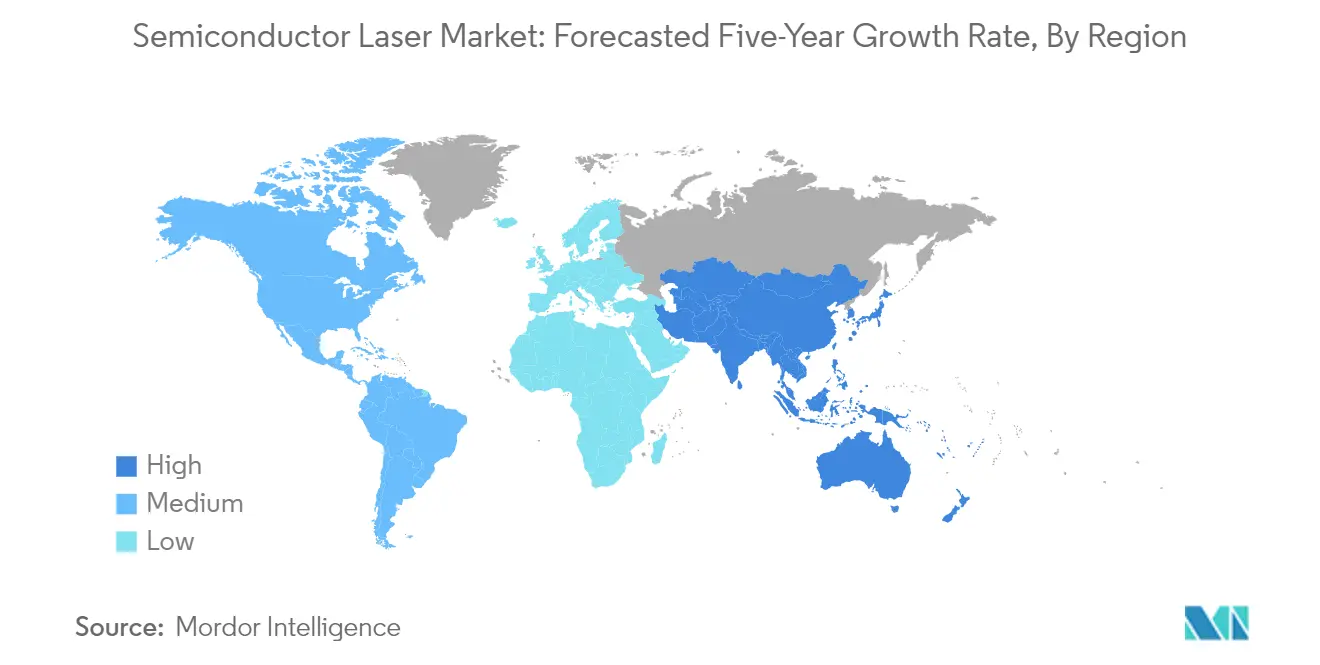
Semiconductor Laser Market in Europe
The European semiconductor laser market has demonstrated robust growth, with an approximate 6% growth rate from 2019 to 2024. The region's market is characterized by strong technological innovation and research capabilities, particularly in countries like Germany and the United Kingdom. The automotive industry remains a key driver for semiconductor laser industry adoption, with European manufacturers increasingly incorporating laser-based systems in their production processes and vehicle components. The region's commitment to industrial modernization and Industry 4.0 initiatives has accelerated the adoption of laser-based manufacturing solutions. The presence of well-established research institutions and technological centers has fostered continuous innovation in laser technology applications. Additionally, the growing focus on renewable energy and environmental technologies has created new applications for semiconductor lasers in monitoring and testing equipment. The healthcare sector's modernization and increasing adoption of laser-based medical devices have further contributed to market expansion. Europe's strong emphasis on quality manufacturing and precision engineering continues to drive demand for advanced laser solutions across various industrial applications.
Semiconductor Laser Market in Asia-Pacific
The Asia-Pacific semiconductor laser market is poised for exceptional growth, with a projected growth rate of approximately 8% from 2024 to 2029. The region has emerged as a global manufacturing hub for electronic components and devices, driving significant demand for semiconductor lasers. China's rapid industrialization and technological advancement have positioned it as a key market driver within the region. The robust electronics manufacturing sector, particularly in countries like South Korea, Japan, and Taiwan, continues to fuel market growth through increased adoption of laser-based manufacturing processes. The region's expanding telecommunications infrastructure and the aggressive rollout of 5G networks have created substantial opportunities for semiconductor laser market applications. The growing automotive sector, particularly in electric vehicle manufacturing, has increased demand for laser-based solutions in production and testing processes. Additionally, the increasing adoption of automation and smart manufacturing practices across the region has created new opportunities for laser technology applications. The region's focus on technological self-sufficiency and domestic semiconductor production capabilities has further strengthened the semiconductor laser market forecast.
Semiconductor Laser Market in Latin America
The Latin American semiconductor laser market is experiencing steady growth driven by increasing industrial modernization and technological adoption. The region's automotive manufacturing sector, particularly in countries like Mexico and Brazil, has been a key driver for semiconductor laser industry applications in production processes. The growing focus on improving manufacturing capabilities and adopting advanced technologies has created new opportunities for laser-based solutions. The telecommunications sector's expansion and the increasing demand for high-speed internet connectivity have driven the adoption of fiber-optic communications, where semiconductor lasers play a crucial role. The region's healthcare sector modernization has also contributed to market growth through increased adoption of laser-based medical devices and procedures. Additionally, the growing electronics manufacturing sector, supported by foreign investments and government initiatives, has created new opportunities for market for semiconductor laser applications. The region's efforts to enhance its technological capabilities and industrial infrastructure continue to drive market development.
Semiconductor Laser Market in Middle East & Africa
The Middle East & Africa semiconductor laser market is showing promising development, driven by increasing investments in industrial infrastructure and technological advancement. The region's focus on diversifying its economy beyond traditional sectors has created new opportunities for advanced manufacturing technologies, including semiconductor lasers. The growing telecommunications sector, particularly in Gulf Cooperation Council (GCC) countries, has increased demand for optical communication systems utilizing semiconductor lasers. The region's healthcare sector modernization has also contributed to market growth through the adoption of advanced medical equipment and procedures. Industrial development initiatives across various countries have created new applications for laser-based manufacturing and processing solutions. The increasing focus on defense and security applications has further expanded the market for semiconductor laser technologies. Additionally, the region's growing emphasis on developing domestic technological capabilities has created new opportunities for market expansion. The ongoing infrastructure development projects and industrial modernization efforts continue to drive the adoption of laser diode market technologies across various applications.
Semiconductor Laser Market Overview
Top Companies in Semiconductor Laser Market
The semiconductor laser market features prominent players like Coherent Inc., Sharp Corporation, Nichia Corporation, II-VI Corporation, and IPG Photonics, leading innovation and market development. These semiconductor laser companies demonstrate a strong focus on research and development activities to enhance their product portfolios, particularly in areas like VCSEL technology, high-power fiber lasers, and specialized laser diode solutions. Strategic partnerships with universities and research institutions have become increasingly common to accelerate technological advancement. Companies are actively expanding their manufacturing capabilities across Asia-Pacific while simultaneously strengthening their presence in established markets through acquisitions and facility expansions. The industry witnesses continuous product launches targeting emerging applications in medical devices, autonomous vehicles, and advanced manufacturing, with companies investing heavily in developing customized solutions for specific end-user requirements. Vertical integration strategies are being adopted to maintain better control over supply chains and quality standards, while geographic expansion focuses on establishing a strong local presence in high-growth markets.
Market Consolidation Drives Industry Evolution Pattern
The semiconductor laser industry exhibits a complex competitive structure characterized by both global conglomerates and specialized manufacturers operating across different market segments. Large multinational corporations leverage their extensive resources and established distribution networks to maintain market dominance, while specialized players carve out niches through technological expertise in specific applications. The market demonstrates moderate to high consolidation, with major players actively pursuing strategic acquisitions to enhance their technological capabilities and market reach. The presence of strong regional players, particularly in Asia-Pacific, creates a dynamic competitive environment where local expertise meets global capabilities. The industry's high barriers to entry, including substantial capital requirements and technical expertise, contribute to maintaining the existing competitive structure while encouraging strategic partnerships among established players.
Recent years have witnessed significant merger and acquisition activities, particularly focused on acquiring innovative technologies and expanding geographical presence. Companies are increasingly pursuing vertical integration strategies to strengthen their position in the value chain, from component manufacturing to system integration. The market shows a trend toward consolidation among mid-sized players to achieve economies of scale and enhance competitive positioning against larger corporations. Strategic alliances and joint ventures have become common approaches to access new markets and technologies while maintaining competitive advantages in core business areas. The industry's competitive landscape continues to evolve with increasing emphasis on intellectual property rights and patent portfolios as key differentiators.
Innovation and Adaptability Drive Market Success
Success in the semiconductor laser market increasingly depends on companies' ability to innovate while maintaining operational efficiency and market responsiveness. Incumbent players must focus on continuous product development, particularly in emerging applications like autonomous vehicles, medical devices, and advanced manufacturing processes. Building strong relationships with end-users through customized solutions and technical support services has become crucial for maintaining market share. Companies need to balance investment in research and development with operational efficiency to remain competitive while managing the high costs associated with technological advancement. The ability to quickly adapt to changing market demands and regulatory requirements, particularly in medical and defense applications, remains crucial for sustained success.
For emerging players and market contenders, success lies in identifying and exploiting niche market opportunities while building technological expertise in specific applications. The increasing concentration of end-users in sectors like telecommunications and consumer electronics necessitates strong customer relationship management and application-specific expertise. Companies must carefully navigate potential substitution risks from emerging technologies while maintaining focus on core competencies and market differentiation. Regulatory compliance, particularly in medical and defense applications, continues to shape market entry strategies and product development priorities. Future success will increasingly depend on companies' ability to build strategic partnerships, maintain technological leadership in chosen market segments, and effectively manage supply chain relationships while adapting to evolving industry standards and requirements.
Semiconductor Laser Market Leaders
-
Coherent Corporation
-
Sharp Corporation
-
Nichia Corporation
-
IPG Photonics Corporation
-
TT Electronics
- *Disclaimer: Major Players sorted in no particular order
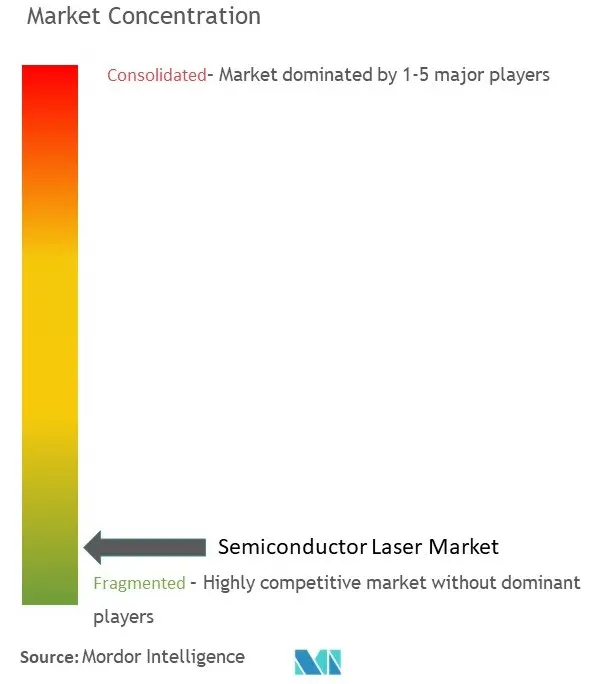
Semiconductor Laser Market News
- November 2023 - The Air Force Research Laboratory opened a new Semiconductor Laser Indoor Propagation Range, known as SLIPR, at Kirtland Air Force Base in New Mexico to support research and development of future laser system propagation studies. SLIPR has 100-meter-long broadcast ranges in an indoor facility to test semiconductor laser technology concepts and includes photoluminescence and X-ray laboratories to characterize molecular beam epitaxy products.
- September 2023 - AMS OSRAM AG and the Malaysian Investment Development Authority (MIDA) announced mutual support for the continued investment and expansion in Malaysia. Through a Collaborative Agreement, MIDA demonstrates significant support for AMS OSRAM’s initiatives in Malaysia.
Semiconductor Laser Market Report - Table of Contents
1. INTRODUCTION
- 1.1 Study Assumptions and Market Definition
- 1.2 Scope of the Study
2. RESEARCH METHODOLOGY
3. EXECUTIVE SUMMARY
4. MARKET INSIGHTS
- 4.1 Market Overview
- 4.2 Industry Value Chain Analysis
-
4.3 Industry Attractiveness - Porter's Five Forces Analysis
- 4.3.1 Bargaining Power of Suppliers
- 4.3.2 Bargaining Power of Buyers/Consumers
- 4.3.3 Threat of New Entrants
- 4.3.4 Threat of Substitutes Products
- 4.3.5 Intensity of Competitive Rivalry
- 4.4 Impact of COVID-19 and Other Macroeconomic Factors on the Market
- 4.5 Tech Snapshot
5. MARKET DYNAMICS
-
5.1 Market Drivers
- 5.1.1 Proliferation of Semiconductor Laser Applications
- 5.1.2 Growth in the Fiber Laser Market
- 5.1.3 Preference for Semiconductor Lasers Over Other Light Sources
-
5.2 Market Challenges
- 5.2.1 Difficulties Regarding Reliability and Testing
6. MARKET SEGMENTATION
-
6.1 By Wavelength
- 6.1.1 Infrared Lasers
- 6.1.2 Red Lasers
- 6.1.3 Green Lasers
- 6.1.4 Blue lasers
- 6.1.5 Ultraviolet Lasers
-
6.2 By Type
- 6.2.1 EEL (Edge-emitting Laser)
- 6.2.2 VCSEL (Vertical-cavity Surface-emitting Laser)
- 6.2.3 Quantum Cascade Laser
- 6.2.4 Fiber Laser
- 6.2.5 Other Types
-
6.3 By Application
- 6.3.1 Communication
- 6.3.2 Medical
- 6.3.3 Military and Defense
- 6.3.4 Industrial
- 6.3.5 Instrumentation and Sensor
- 6.3.6 Automotive
- 6.3.7 Other Applications
-
6.4 By Geography
- 6.4.1 North America
- 6.4.2 Europe
- 6.4.3 Asia
- 6.4.4 Australia and New Zealand
- 6.4.5 Latin America
- 6.4.6 Middle East and Africa
7. COMPETITIVE LANDSCAPE
- 7.1 Vendor Positioning Analysis
-
7.2 Company Profiles*
- 7.2.1 Coherent Inc
- 7.2.2 Sharp Corporation
- 7.2.3 Nichia Corporation
- 7.2.4 IPG Photonics Corporation
- 7.2.5 TT Electronics
- 7.2.6 Sumitomo Electric Industries, Ltd.
- 7.2.7 Sheaumann Laser, Inc.
- 7.2.8 Newport Corporation (mks Instruments, Inc.)
- 7.2.9 Panasonic Industry Co., Ltd
- 7.2.10 Rohm Company Limited
- 7.2.11 Hamamatsu Photonics K.K
- 7.2.12 Jenoptik Laser GMBH
- 7.2.13 TRUmpF Group
- 7.2.14 ams OSRAM AG
- 7.2.15 Lumentum Holdings Inc.
8. INVESTMENT ANALYSIS
9. FUTURE OF THE MARKET
Semiconductor Laser Market Industry Segmentation
Semiconductor lasers based on semiconductor gain media involving optical amplification are achieved by stimulated emission at an interband transition under conditions of a high carrier density in the conduction band. Most of these are laser diodes that are pumped with an electrical current.
The Semiconductor Laser Market is segmented by wavelength (infrared lasers, red lasers, green lasers, blue lasers, ultraviolet lasers), by type (EEL (Edge-emitting Laser), VCSEL (Vertical-cavity Surface-emitting Laser), quantum cascade laser, fiber laser, other types), by application (communication, medical, military and defense, industrial, instrumentation and sensor, automotive, other applications), by geography (North America, Europe, Asia Pacific, Latin America, Middle East and Africa). The market sizes and forecasts are provided in terms of value (USD) for all the above segments.
| By Wavelength | Infrared Lasers |
| Red Lasers | |
| Green Lasers | |
| Blue lasers | |
| Ultraviolet Lasers | |
| By Type | EEL (Edge-emitting Laser) |
| VCSEL (Vertical-cavity Surface-emitting Laser) | |
| Quantum Cascade Laser | |
| Fiber Laser | |
| Other Types | |
| By Application | Communication |
| Medical | |
| Military and Defense | |
| Industrial | |
| Instrumentation and Sensor | |
| Automotive | |
| Other Applications | |
| By Geography | North America |
| Europe | |
| Asia | |
| Australia and New Zealand | |
| Latin America | |
| Middle East and Africa |
Semiconductor Laser Market Research FAQs
How big is the Semiconductor Laser Market?
The Semiconductor Laser Market size is expected to reach USD 9.34 billion in 2025 and grow at a CAGR of 13.40% to reach USD 17.52 billion by 2030.
What is the current Semiconductor Laser Market size?
In 2025, the Semiconductor Laser Market size is expected to reach USD 9.34 billion.
Who are the key players in Semiconductor Laser Market?
Coherent Corporation, Sharp Corporation, Nichia Corporation, IPG Photonics Corporation and TT Electronics are the major companies operating in the Semiconductor Laser Market.
Which is the fastest growing region in Semiconductor Laser Market?
Asia Pacific is estimated to grow at the highest CAGR over the forecast period (2025-2030).
Which region has the biggest share in Semiconductor Laser Market?
In 2025, the Asia Pacific accounts for the largest market share in Semiconductor Laser Market.
What years does this Semiconductor Laser Market cover, and what was the market size in 2024?
In 2024, the Semiconductor Laser Market size was estimated at USD 8.09 billion. The report covers the Semiconductor Laser Market historical market size for years: 2019, 2020, 2021, 2022, 2023 and 2024. The report also forecasts the Semiconductor Laser Market size for years: 2025, 2026, 2027, 2028, 2029 and 2030.
Our Best Selling Reports
Semiconductor Laser Market Research
Mordor Intelligence provides comprehensive industry analysis and market outlook for the semiconductor laser market, covering vital segments like vcsel, quantum cascade laser, and photonic integrated circuit technologies. Our detailed market forecast encompasses growth drivers, industry statistics, and market value assessments across key applications in telecommunications, industrial manufacturing, and healthcare sectors. The industry research delves deep into emerging trends in laser diode technologies, semiconductor optical amplifier developments, and optoelectronic semiconductor innovations, with all insights available in an easy-to-read report PDF format that aids strategic decision-making.
Our consulting expertise extends beyond traditional market research to provide technology scouting services that help identify breakthrough developments in semiconductor laser technologies, particularly in quantum well laser and edge emitting laser segments. We support businesses with comprehensive R&D and patent analysis, focusing on emerging photonic semiconductor technologies and novel optical semiconductor applications. Our team conducts detailed B2B surveys and interviews with industry experts, providing invaluable insights into technology adoption trends and future market directions. Through advanced data aggregation and visualization techniques, we help stakeholders understand complex market dynamics, evaluate new product opportunities, and develop effective go-to-market strategies in the rapidly evolving laser diode market.

